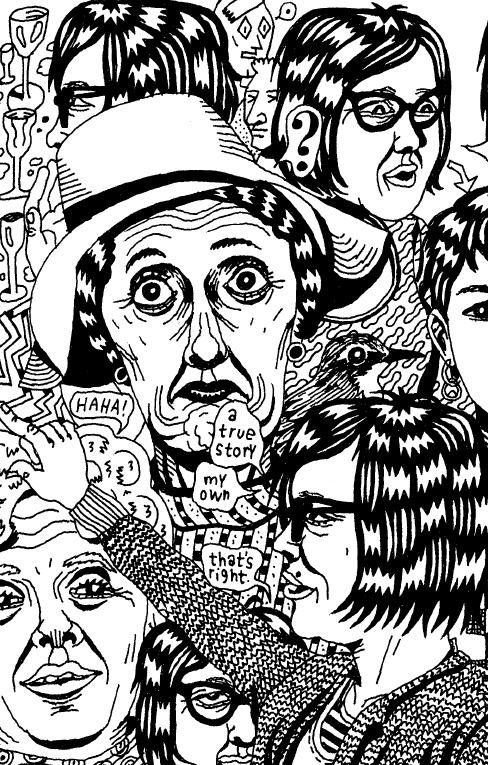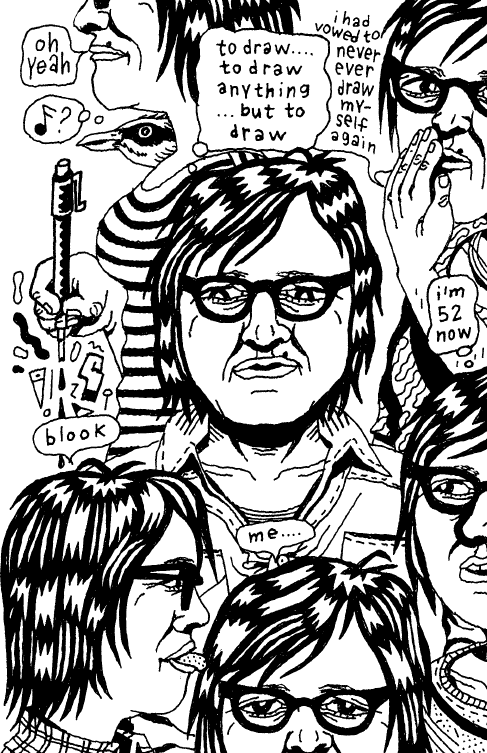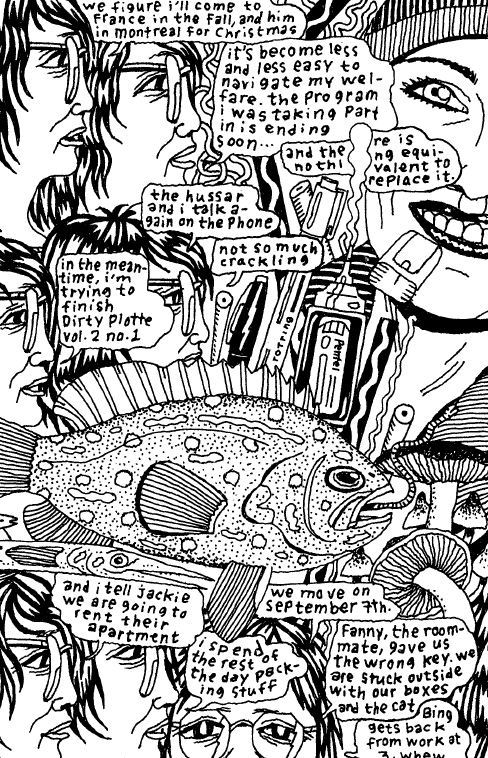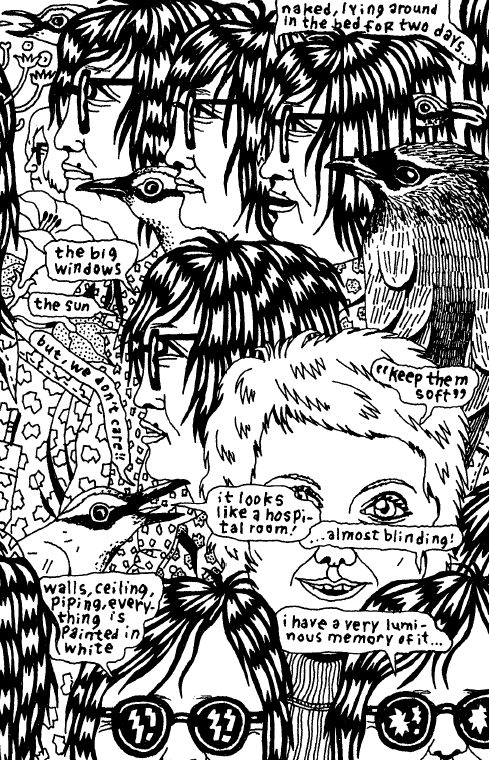“the past. it’s like a big sugary milkshake.”
“that milkshake...”
“too sweet”
Time Zone J is a graphic novel by Julie Doucet about returning to comics - not only to the craft but to the scene, and the artist’s memories of her life as a cartoonist. Drawn & Quarterly’s ad copy declares this her first comic since she “famously quit in the nineties,” a declaration that puzzled me at first, as her 2016 avant-fotoromanzo Carpet Sweeper Tales was certainly sequential art. However, it was clear to me upon beginning to read Time Zone J why this would be heralded as a return - from the first 'page', Julie confronts the reader in the process of a difficult decision, to begin drawing again, to begin drawing herself again. She whines to herself about the task: “to draw… to draw anything… but to draw… I had vowed never to draw myself again… I'm 52 now.”
And draw herself she does - our entry into the work is a symphony of faces, Julie Doucet’s face. You remember her from the pages of Dirty Plotte. It’s Julie, the punk cartoonist goddess of Montreal, with that shocking jagged hair and snarling lines of perfect markmaking. I think of Julie as she envisioned herself on the cover of the first issue of Dirty Plotte: her sunken eyes, toothy grin, her unshowered, grubby countenance, her bare leg lifted just enough to let the reader know, yes, her cunt smells too. It was a different kind of womanhood that underground comics was always meant to convey, but few before her had the guts to show her to us. That was Julie then. Now she is older, tired, bespectacled in heavy frames. Elegant wrinkles adorn her face in those familiar jagged lines, which finely complement the mole above her upper lip. She wears sweaters, she wears button up shirts - her hair still a bit ratty and disheveled but at a respectable, vaguely soft butch length. This is Julie today, a woman who leads a private life, provocations behind her, stress to manage, content with quiet moments, at peace. But it's Julie. Over 20 years later, it’s her.
And so we once again fall into Julie Doucet’s life as told through her pen on paper, but it isn’t the place we remember. It’s the life she remembers. Time Zone J is a noisy comic, unfurling Doucet’s lifetime memories in an obsessively scrawled jumble: a forest of faces butting up against word balloons, thought bubbles, animals, fabrics, details, graphics, half-empty coffee cups, mosaics of patterns and ephemera, with nary a panel in sight to contain the sequence. Time Zone J does not even have pages, not really - drawn as a continuous spread, each page is connected at its edge to the next as a reminder that no boundaries exist between any sequence in this comic; no moment stands alone, except perhaps the blank verso of each folded, bound sheet, gaps that catch the beholder’s eye like little sighs. Perhaps, like the finale of Promethea, this could be a comic best read if the binding is destroyed (maybe stick it in the microwave?).
How to read Time Zone J? Doucet states: “This book was drawn from bottom to top. Please read accordingly.” Like Carpet Sweeper Tales’ “READ IT OUT LOUD” the task given the reader is easier said than done, but upon contemplation the art itself provides a bit of context to its aesthetic purpose. After attempting several methods, I found that reading the work in a 'traditional' sequence was more legible for following the text, but viewing the art alone—beginning from the bottom third of the page and moving leftward to the end, and then repeating from the top after reaching the end—created a more linear view of the artwork and its progression: an animation of Julie thinking pensively, interspersed with visions of her memories and reflections of her past, everything she ever loved. No way of reading this work makes 'sense'. It isn’t an obtuse work of sequential art, really, but it resists a clean sequence. 'Snaking it' a la Brian Chippendale won’t always help you here. Everything bleeds into everything else; any smooth motion will be disrupted somewhere, nothing can be separated. Time Zone J is a dream of comics that passes through your fingers and crams itself into your eyes, unnamable shit, the raw power that modernist fiction goes for that lives somewhere between impenetrable and the most understanding expressions you’ve ever seen. It made sense to Julie, when she made it.
Time Zone J is the story of Julie Doucet’s life. Her childhood, her splendid days as an enfant terrible of alt comics, her pen pals, her periods (of course), scrapbooks and old letters, diary entries, awful boyfriends, travel, books and music and all the beautiful people and all her friends, the self-harm, great and terrible days and daydreams and daydreams of bygone days. Julie’s past is so full of stuff, so full of awful awful nightmares, so full of pride, remorse, body fluids, feminine strength. Some stories she has told before—Doucet is hardly a stranger to bearing it all, she’s best known for comics that bore the title of her filthy pussy—while other stories will shock readers. Time Zone J is Doucet’s most revealing comic ever. She commits to the page as much of her mind as humanly possible. Among the many wonders she reveals is her dignity, as a cartoonist and as a woman.
Nearly midway through the sequence of Time Zone J, a painful story emerges: a tortured romance with a French man she calls the hussar, begun as a pen pal, developing over his time in military service, culminating in meetings marked by violence, disappointment and alienation. During this time, Doucet began work on what became the first two D&Q issues of Dirty Plotte. Doucet reveals a story of stunning emotional trauma which—however real, however fictionalized, however remembered—unravels itself as a backdrop to the first of her comics which readers might remember. In one letter which Doucet recounts early in her reminiscence, the hussar writes, “julie everything reminds me of you: Earth is divided into 25 time zones, each being represented by a letter. only J is not used.” Time Zone J is a work in which Julie’s life occupies that unmarked zone, her inner world. As everything once reminded the hussar of Julie, the zone and its flood of words and pictures draw Julie deeper into her own memories. D&Q’s ad copy declares this a comic in which Doucet creates “an alternate universe which foregrounds women,” but this is not a comic about all women. It’s about Julie. And it’s also about a man she loved, and then feared, and then never heard from again - a drama that has no conclusion save for its being over.
As the comic progresses, Time Zone J becomes denser, heavier in text, Julie’s monologue taking the place of the hussar’s visage. Figuring out the sequence becomes more consequential to the reader, and yet it is from here on out that the work resists comprehension: a rush of noise, words, details without order yet full of grief and sensitivity confronting the reader as if escaping us. As I read, I found Time Zone J escaping me, its density overwhelming me, my eyes glided across images and refused to rest upon words long enough to claim Julie’s story. Reading Time Zone J becomes a practice much like recovering one’s own memory, which can never be contained as a story, the fog that must be pushed through to reach all the sounds and visions of our past. It begins like a dream journal, becoming a dramatic exploration of past trauma, then dissolving unresolved into the present moment like so many ended sessions of therapy. Finally the curtain closes, you worry you didn’t understand it all, you fret over the words you glossed over as her stories overwhelmed you, you promise yourself to read more closely later, you put down the book. Julie Doucet’s life goes back on the shelf. She takes back the life she spilled onto the page, hers until another day she might share her life with us again. She is still here.











